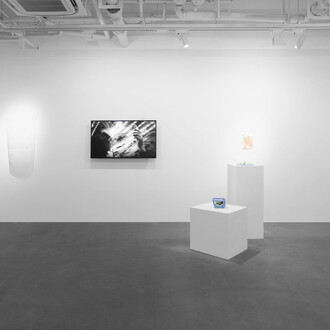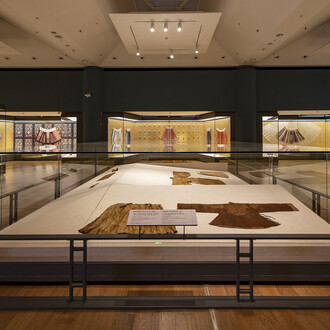Perrotin is pleased to present the solo exhibition “The Last Sunset” of the Chinese artist Ni Youyu in Shanghai, following last year’s exhibition “So Near Yet So Far” at Perrotin Hong Kong. The exhibition will showcase different series of paintings by Ni Youyu, including his signature “Water washing painting” and “Ancient Archive Specimen” series, as well as the artist’s latest installation works—in the endeavor to present from diverse angles the intricate threads and linkages within the artist’s oeuvre.
Viewing Ni Youyu’s work often leaves one with a spatial and temporal illusion: outsiders may have difficulty, at first glance, in determining the age of the artist and indeed the age of the works. The artist seems intent on avoiding temporal marks in his oeuvre, instead imbuing his artworks with an abstract trace. Ni Youyu asserts that he is not keen on the “conceptual”, even hesitating in calling what he makes as belonging to “contemporary art”. For many years now, the artist has gone against the grain, even working in a “low-technique” mode. Many of his artworks often undergo a long process (some as long as several years) and go through a degree of uncertainty from gestation to completion. It is impossible, therefore, for him to work programmatically “on order” in the manner of artisans in the classical sense, and for that matter it is also difficult for him to produce works according to an exhibition theme in the manner of a modern artist.
Around 2009, Ni Youyu began his experimentation with “Water washing painting”. It started haphazardly: after years of training in traditional Chinese painting, the artist tried teaching himself painting on canvas, yet his unfamiliarity with the material forced him at first to repeatedly wash off unsatisfactory images. In this process of continual correction, the canvas was left with a textural effect akin to wulouhen—a Chinese calligraphic stroke that likens the trailing of ink to rainwater trickling through the crevices of dilapidated walls. Very sensitively catching this detail, the artist consciously started to focus his experimentation on this technique. After a long process of practice, he gradually grasped a new painting technique: by varying the quantity and force with which the water flows— cutting against and washing out acrylic paint at varying degrees of moisture— this technique is both controllable and uncontrollable, additive and subtractive at once. The water becomes at times like a brush, and at other times like an etching knife; it fuses with the brushstrokes on the canvas in forging the traces of texture and patina similar to historical weathering. This apparently simple technique happens to manifest a complex yet distinctive effect—viewing at varying distances, the viewer is left with diverse sensations as conveyed by the idiom of the painting: from afar (or from photographs), one mistakenly sees a traditional ink painting or woodcut; closer up, however, one notices how the brushstrokes are imbued with Expressionist flair. Behind these seemingly “restrained” picture planes lies a violent process of destruction. His “Water washing painting” thus generates, within the modern circulation of media, a certain “deceit”. For Ni Youyu, the essence of painting is deceptive; a seemingly luxurious golden hue on the picture plane is, in its origin, a “Deceptive Light”(in 2017, Perrotin assisted the artist in editing a documentary video about “Water washing painting”, entitled Deceptive Light). With the passing of time and the washes of water, the remnant on the painting surface happens to be a “golden relic”, just like the dazzling light of sunset.
This exhibition marks another stage with this series of paintings after the solo exhibition “Concrete Waterfall” at Kunstverein Konstanz in Germany in 2017. Included here is The Last Sunset in the Museum, the largest painting to date in this series, along with 20 smaller works presented in antique frames. Taking the 16th-century Italian artist Ferrante Imperato’s lithographs of a naturalhistory Wunderkammer (cabinet of curiosity) as the blueprint, the work shows the artist tracing back historical origins. The encyclopedic typological research as manifested in cabinets of curiosities constitutes both a fundamental model by which modern humans cognize the world and also the incipient model of the modern museum. Ni Youyu spent nearly half a year in portraying anew this work of Renaissance humanist pictorial representation. In this massive painting crammed with details, the artist fully displays the expressivity particular to “Water washing painting” all the while re-selecting according to his own personal tastes a “museum” displaced in space and time. Worth mentioning here is the fact that Huqiu Road, where Perrotin Shanghai is located, was originally named “Museum Road” as the birthplace of China’s first museum. In imitating the mood and scene of an abandoned classical museum under the title of The Last Sunset in the Museum, Ni Youyu inevitably generates, for the viewer, even more associations.
Similar displacements in space and time are present within the inner space of the gallery. The artist has set up the exhibition space as a dim museum hall, with the resplendent antique frames exhibiting a series of scenes classically composed and suffused with historical metaphors—at once distorting and paying homage to works by such great masters as René Magritte, Vincent van Gogh, Giorgio de Chirico, Edvard Munch, among others. These small-scale paintings were completed by the artist in the bathrooms of various apartments while travelling and living in Europe from 2017 to 2019. In these narrow bathrooms, the artist worked next to the bathtub with watering cans and shower heads. What bears reminding is that the artist first collected these antique frames from different countries, and then conceived of the portrayed content according to the ratios and decorative styles of the frames. With respect to the tradition of setting frames according to the painting, this makes for a creative process in reverse. Postmodernist painters emphasize discarding the frame to redefine painting, while Ni Youyu is obviously and consciously running counter to this principle. In the end, the golden picture plane and the resplendent frames mutually correspond, forming a fictive sense of the “classical” and rendering the exhibition space very much like a late-19th-century salon.
The “Ancient Archive Specimen” series is an equally representative series of works by the artist, and moreover an important point of connection between the artist’s paintings and installations. The series employs pictorial language to portray several hard-to-realize installation proposals or collection projects. The artist frequently gathers all kinds of ancient prints, which he manually colors, cuts and collages onto the canvas; he then paints, combining acrylic, oil paint, lacquer, pastels, and other materials. The entire process appears to contain on the canvas a flat, virtual installation. As with the vast majority of the artist’s installation works, he seems very much interested in vessels with a “limiting” quality, like antique furniture, specimen cabinets, and so on. Encyclopedically, the artist gathers and integrates, forging a virtual spectacle—in truth drawing an assortment of similes in the forest-like ecology of humanist history.
Mallarmé once said that the work of an artist’s entire life will finally compile into a complete oeuvre. This oeuvre has as its centers of attraction several key foci, with the works constituting amongst them a mutually interpretive and mutually supplementary universe. Revolving around his reflections on art history and on nature, Ni Youyu marches to his own drum beat, engrossed in creating his own distinctive system of art.
















